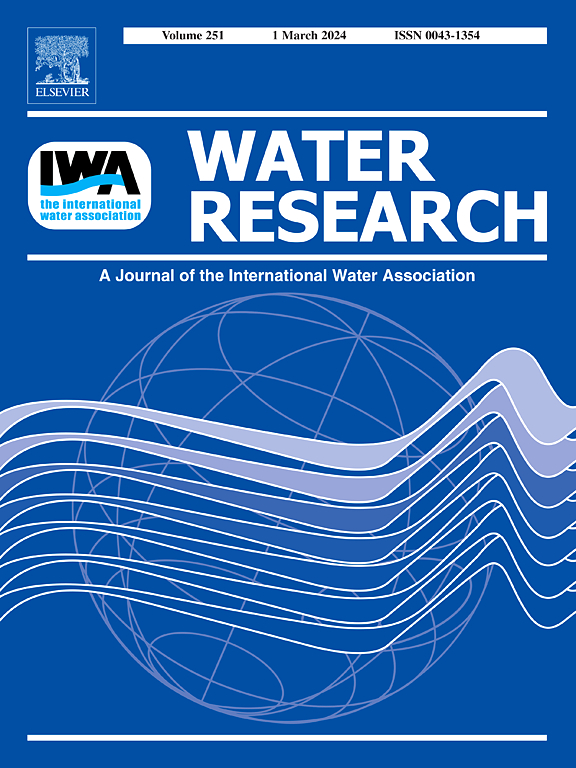Adsorption and immobilization of phosphorus in eutrophic lake water and sediments by a novel red soil based porous aerogel
IF 11.4
1区 环境科学与生态学
Q1 ENGINEERING, ENVIRONMENTAL
引用次数: 0
Abstract
To effectively mitigate global eutrophication in lakes, regulating sedimentary phosphorus release remains a primary strategy. Enhancing the adsorption and stabilization performance of passivating agents is integral to addressing endogenous phosphorus pollution in aquatic systems. This study presents a novel aerogel with a high specific surface area (663.06 m²/g) and a mean pore size of 2.78 nm, synthesized from cost-effective and abundant red soil. Batch experiments demonstrated that the red soil aerogel (RSA) achieved a maximum phosphorus adsorption capacity of 23.29 mg P/g, surpassing lanthanum-modified bentonite (LMB) by 1.5 times. The RSA exhibited phosphorus removal efficiencies between 82% and 97% across a pH range of 4 to 9. Moreover, RSA retained a removal rate exceeding 95% in the presence of common ions (SO42-, Cl-, and NO3-) at concentrations of 100 mg/L, showing minimal performance reduction even under high HCO32- concentrations. The comprehensive analysis identifies electrostatic attraction, ligand exchange, and Lewis acid-base interactions as the primary mechanisms driving phosphate adsorption onto the RSA surface. RSA exhibited a strong capacity to immobilize phosphorus within sediments, achieving an 83.0% to 97.5% reduction in endogenous phosphorus release into the overlying lake water and promoting the conversion of mobile phosphorus into NaOH-P. After 38 days of hypoxic incubation, active phosphorus levels in surface sediments were reduced by over 60% compared to the control group. The findings highlight RSA's potential as an effective passivating agent for mitigating internal pollution. This study presents a cost-efficient porous silicon-aluminum aerogel with high phosphorus adsorption efficiency, synthesized using the readily available red soil from southern China, offering a viable strategy to address endogenous phosphorus release in eutrophic lake environments.

新型红土基多孔气凝胶对富营养化湖泊水体和沉积物中磷的吸附与固定化
为了有效缓解全球湖泊富营养化,调节沉积磷释放仍然是一个主要策略。提高钝化剂的吸附和稳定性能是解决水生系统内源磷污染的必要条件。本研究提出了一种新型的气凝胶,具有高比表面积(663.06 m²/g),平均孔径为2.78 nm,以经济高效和丰富的红壤为原料合成。批量实验表明,红壤气凝胶(RSA)对磷的最大吸附量为23.29 mg P/g,是镧改性膨润土(LMB)的1.5倍。在4 ~ 9的pH范围内,RSA的除磷效率在82% ~ 97%之间。此外,在100 mg/L的普通离子(SO42-、Cl-和NO3-)存在下,RSA的去除率保持在95%以上,即使在高HCO32-浓度下也表现出最小的性能下降。综合分析确定静电吸引、配体交换和刘易斯酸碱相互作用是驱动磷酸盐吸附到RSA表面的主要机制。RSA对沉积物中的磷具有很强的固定化能力,使上覆湖水中内源磷释放量减少83.0% ~ 97.5%,并促进了流动磷向NaOH-P的转化。经过38天的缺氧培养,与对照组相比,表层沉积物中的活性磷水平降低了60%以上。研究结果强调了RSA作为一种有效的钝化剂的潜力,可以减轻内部污染。本研究提出了一种经济高效的多孔硅铝气凝胶,该气凝胶具有高磷吸附效率,利用中国南方现成的红壤合成,为解决富营养化湖泊环境中内源磷释放提供了可行的策略。
本文章由计算机程序翻译,如有差异,请以英文原文为准。
求助全文
约1分钟内获得全文
求助全文
来源期刊

Water Research
环境科学-工程:环境
CiteScore
20.80
自引率
9.40%
发文量
1307
审稿时长
38 days
期刊介绍:
Water Research, along with its open access companion journal Water Research X, serves as a platform for publishing original research papers covering various aspects of the science and technology related to the anthropogenic water cycle, water quality, and its management worldwide. The audience targeted by the journal comprises biologists, chemical engineers, chemists, civil engineers, environmental engineers, limnologists, and microbiologists. The scope of the journal include:
•Treatment processes for water and wastewaters (municipal, agricultural, industrial, and on-site treatment), including resource recovery and residuals management;
•Urban hydrology including sewer systems, stormwater management, and green infrastructure;
•Drinking water treatment and distribution;
•Potable and non-potable water reuse;
•Sanitation, public health, and risk assessment;
•Anaerobic digestion, solid and hazardous waste management, including source characterization and the effects and control of leachates and gaseous emissions;
•Contaminants (chemical, microbial, anthropogenic particles such as nanoparticles or microplastics) and related water quality sensing, monitoring, fate, and assessment;
•Anthropogenic impacts on inland, tidal, coastal and urban waters, focusing on surface and ground waters, and point and non-point sources of pollution;
•Environmental restoration, linked to surface water, groundwater and groundwater remediation;
•Analysis of the interfaces between sediments and water, and between water and atmosphere, focusing specifically on anthropogenic impacts;
•Mathematical modelling, systems analysis, machine learning, and beneficial use of big data related to the anthropogenic water cycle;
•Socio-economic, policy, and regulations studies.
 求助内容:
求助内容: 应助结果提醒方式:
应助结果提醒方式:


